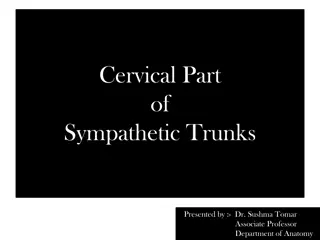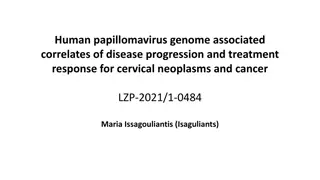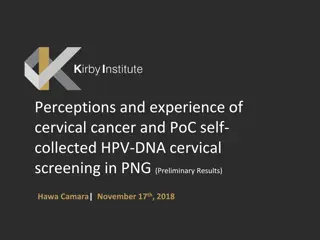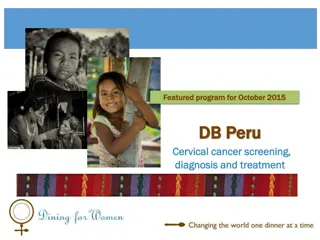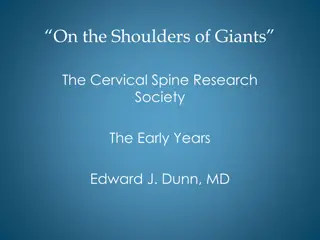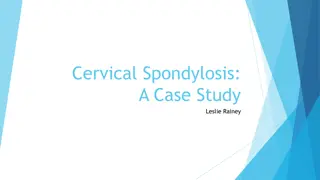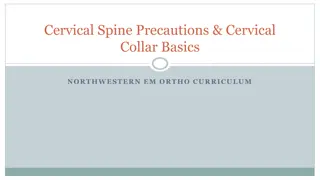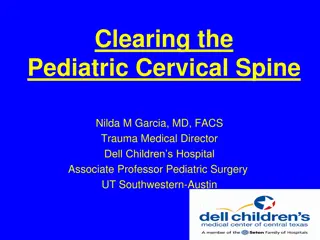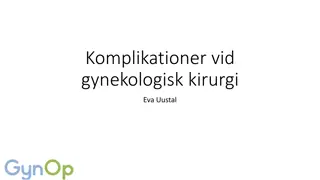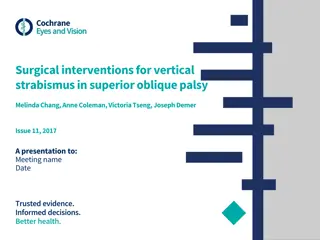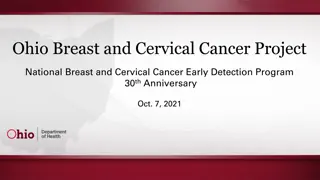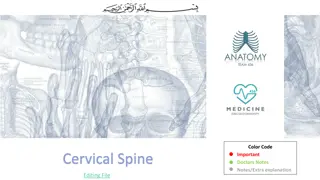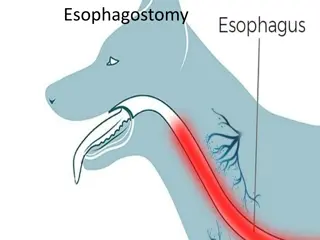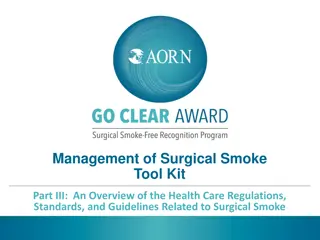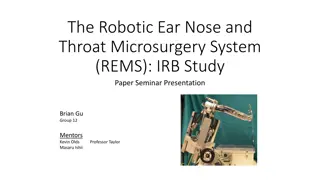Comprehensive Overview of Cervical Conization and Surgical Procedure
Cervical conization is a surgical procedure that involves removing a cone-shaped portion of the cervix. The extent of excision is determined by colposcopy, and the excised specimen is tagged for proper orientation. High accuracy in evaluating CIN grading and stromal invasion can be achieved through conization pathological information. Additional procedures like endocervical curettage and fractional curettage may be performed to exclude residual disease. This comprehensive guide outlines the steps involved in cervical conization and its importance in diagnostic and therapeutic settings.
Download Presentation

Please find below an Image/Link to download the presentation.
The content on the website is provided AS IS for your information and personal use only. It may not be sold, licensed, or shared on other websites without obtaining consent from the author. Download presentation by click this link. If you encounter any issues during the download, it is possible that the publisher has removed the file from their server.
E N D
Presentation Transcript
Cervical Cervical Conization Conization Dr.Yousefi Professor OF Mashhad University of Medical Sciences Gynecologist Oncologist
Cone Biopsy is a surgical procedure with removal of a cone shaped portion of the cervix The extent of involvement of epithelium on the ectocervix has been clearly demarcated by colposcopy Lugol's determination iodine solution aids in this
The endocervical canal is sounded to guide the direction and depth of the excision This incision does not need to be circular but should accommodate excision of all atypical epithelium
The extent of excision must be adjusted according to individual needs A small amount of normal tissue around the cone-shaped wedge of abnormal tissue is also removed so that a margin free of abnormal cells is left in the cervix
The excised specimen is tagged at the 12 o'clock position using suture to allow for proper orientation by the pathologist conization pathological information particularly can provide more exact in the evaluation of CIN grading and stromal invasion
High endocervical involvement fairly accurately is possible Obtaining cytology specimens by performing endocervical curettage or by with an endocervical brush
A fractional curettage of the endocervical canal and endometrium to exclude residual squamous or glandular disease of the upper endocervical canal or of the endometrium
The base of the surgical site maintain hemostasis can be cauterized to or hemostatic sutures The traditional Sturmdorf sutures are not advisable because of the risk of burying residual disease Simple U-sutures placed anteriorly and posteriorly may be used if bleeding persists
Indications conization: (ASCCP) American Society for Colposcopy and Cervical Pathology issued Conization may be used either for diagnostic purposes or for therapeutic purposes to remove pre-cancerous cells
Indications for Diagnostic conization 1.The lesion cannot be fully visualized 2.The ECC is positive 3.There is significant discrepancy between the Pap smear and biopsy 4.A biopsy reveals microinvasive squamous cell carcinoma 5.A biopsy reveals adenocarcinoma in situ
Finding epithelial cell abnormalities in the absence of gross or colposcopic lesions of the cervix HSIL ( CIN II / CIN III ) Unsatisfactory colposcopy AGUS
Therapeutic conization: Treatment of cervical cytological abnormalities CIN grades 2 and 3 Carcinoma in situ
Treatment issued : Ablative or excisional The excisional treatments include (LEEP) conization Cold knife conization The ablative treatments Electrocautery Cold coagulation Cryosurgery Laser
Types excisional conization include: Cold knife conization Usually outpatient, occasionally inpatient loop electrical excision procedure (LEEP) Combined conization usually refers to a procedure started with a laser and completed with a cold-knife technique
benefits and disadvantages Cold-knife conization provides the cleanest specimen margins for further histologic study but it is typically associated with more bleeding than laser or LEEP and it requires general anesthesia in most cases
Laser procedures are of longer duration if low-power density is used may "burn" the margins thus interfering with histological diagnosis the high cost of the procedure The main advantage with this procedure dots produced by the laser energy can be used to accurately outline the exocervical margins
LEEP procedures have several advantages Including: Rapidity preservation of the margins for histological evaluation and virtual bloodlessness can perform LEEP procedures in the office or in other outpatient settings
electro coagulation or cryosurgery Are procedures that do not yield tissue for pathologic studies their use should be limited to those women in whom an accurate preoperative diagnosis has been established by directed biopsy findings
Cold -knife conization : Controversies exist as to the necessity of removing the entire endocervical canal including the internal os, in all cases
Conizaion treatment difficulties: atrophy of the cervix post-menopausal patients not easily observed transformation zone is by colposcopy there are increased conizaion treatment difficulties Therefore, the effectiveness of the treatment of (CIN2 and CIN3) in post-menopausal women needs to be investigated
Side effects of the conizaion may include: cervical stenosis with resulting hematometra (collection of blood in uterus) Intraoperative or postoperative bleeding
If bleeding is heavier and does not settle quickly hemostasis using Monsel's solution Rarely, sutures may be required Infertility Uterine perforation Anesthetic risk increase the risk of incompetent cervix Pregnancy loss and Preterm birth
Prophylactic cervical cerclage Did not prevent preterm delivery The cerclage may itself be a risk factor for preterm delivery Sutures can act as a foreign body which may cause uterine irritability And lead to contractions after a cerclage procedure
Main cause of treatment failure conization : Risk factors of positive margins A larger lesion area Menopausal status Carcinoma in situ LEEP
Risk factors for recurrent isease: Age cytology grade Menopause status Margin involvement HPV genotype HPV viral load Have all been observed as risk factors In CIN treatment
Decrease of risk factors for residual/ recurrent disease after conization Cytology or curettage specimen immediately after conization (glandular involvement)
Predicting the persistence of HPV in CIN after conization HPV genotype 16 And margin status
Restrictions after this procedure? Avoid any activities that require concentration for two days (i.e. driving a car, because some medications may make drowsy or dizzy) Avoid swimming in public swimming pools for about 3 weeks Return to work 5-7 days after surgery
After a cone biopsy Some vaginal bleeding is normal for up to 1 -2 weeks Some vaginal spotting or discharge (bloody or dark brown) may occur for about 3 weeks Sexual intercourse should be avoided for about 3 weeks Douching should not be done for about 2- 3 weeks
Cervical conization achieves cure rates for high-grade CIN of in excess of 95% of cases
Several reasons for the absence of residual dysplasia in LEEP specimens despite of dysplasia is identified by colposcopic biopsy (16.4% - 17.7%)
First, the CIN lesion is focal and small and removed completely by punch biopsy Second, the remaining small lesion after punch biopsy may undergo spontaneous regression Third, CINs are missed and not removed by LEEP Residual disease during follow-up Fourth, the wrong pathological report can be obtained fail pathologist to observe the area that contained the CIN Close follow-up of cases with no dysplasia in LEEP specimens is still needed
Follow-up after conization: Repeat Pap smears and colposcopy should be performed at 6 and 12 months post treatmen
After several normal Pap test the patient may return to annual screenin particularly if a high risk HPV DNA test is negative


